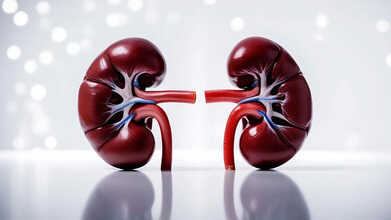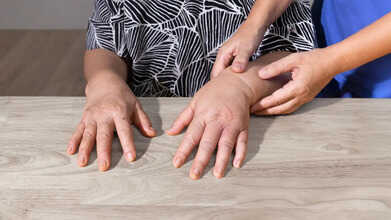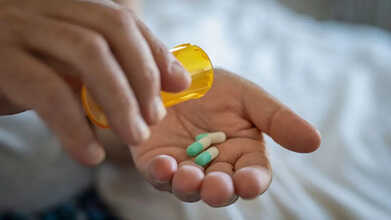- Health Conditions A-Z
- Health & Wellness
- Nutrition
- Fitness
- Health News
- Ayurveda
- Videos
- Medicine A-Z
- Parenting
- Web Stories
Covid Could Be Causing Women To Age Faster; Here’s What Scientists Found

Credits: Canva
Covid could have accelerated arterial ageing by up to five years, with women experiencing the greatest impact, according to groundbreaking research. The study revealed that even mild Covid infections can stiffen blood vessels, a change normally linked to aging, which increases the risk of heart attacks, strokes, and other cardiovascular issues.
Encouragingly, vaccinated individuals generally showed less arterial stiffness compared to those who were unvaccinated. Study leader Professor Rosa Maria Bruno explained that many people affected by Covid continue to experience symptoms months or even years later, and researchers are “still uncovering how the virus triggers these lingering effects.”
The findings follow advice from an emergency doctor who recently highlighted a simple five-second test that could indicate heart problems.
Early Vascular Ageing Explained
Professor Bruno said: “We know Covid can directly impact blood vessels. This can lead to what we term early vascular aging, meaning your arteries are older than your actual age, increasing susceptibility to heart disease. Identifying at-risk individuals early is crucial to preventing heart attacks and strokes.”
How the Study Was Conducted
The research included 2,390 participants from 16 countries, including the UK and the US. Conducted from September 2020 to February 2022, participants were divided into four groups: those who never contracted Covid, those with recent mild infections who were not hospitalised, patients admitted to general wards, and the most severe cases treated in intensive care.
Stiffer Arteries Found Across All Covid Groups
The results were striking as all Covid-infected groups, including those with mild infections, showed stiffer arteries than people who had never been infected. Women were more affected than men, and individuals with long Covid symptoms like fatigue and shortness of breath showed the strongest vascular changes.
Reassuringly, vaccinated participants had less stiff arteries than unvaccinated ones, and over time, the Covid-related vascular ageing tended to stabilise or slightly improve.
How Arterial Stiffness Was Measured
Researchers determined vascular age by measuring how fast a blood pulse travels from the carotid artery in the neck to the femoral arteries in the legs, using a device to calculate carotid-femoral pulse wave velocity (PWV). A higher PWV indicates stiffer blood vessels and a higher vascular age. Measurements were taken six months after infection and repeated at 12 months. The analysis accounted for participants’ sex, age, and other cardiovascular risk factors.
The study found that PWV increased in women by 0.55 metres per second for mild Covid cases, 0.60 for hospitalised women, and 1.09 for those in intensive care. Researchers note that an increase of 0.5 metres per second is “clinically significant,” roughly equivalent to five years of vascular ageing, and raises the cardiovascular risk by 3 percent in a 60-year-old woman.
How Covid Affects Blood Vessels
Professor Bruno from Université Paris-Cité explained: “Covid-19 targets angiotensin-converting enzyme 2 receptors found on blood vessel linings. By entering these cells, the virus can cause vascular dysfunction and speed up arterial ageing. Our immune and inflammatory responses, which normally protect against infection, may also contribute to this damage.”
Covid Could Be Causing Women To Age Faster
Discussing the sex differences, she added: “Women generally mount a faster, stronger immune response, which helps defend against the infection. However, this same response can sometimes increase damage to the blood vessels after the virus has passed.”
The study found that Covid’s impact extends far beyond the respiratory system, silently affecting blood vessels and accelerating vascular aging, especially in women. While vaccination appears to offer some protection, awareness and early monitoring of heart health are important.
Hyderabad Faces Surge in Mysterious Kidney Disease Among Healthy Youth, Study Finds

Credits: Canva
A chronic kidney disorder of unknown origin, referred to as Chronic Kidney Disease of unknown etiology (CKDu), is leading to kidney failures in Hyderabad and nearby districts of Telangana, alarmingly affecting younger adults who are economically active and have no prior history of diabetes or high blood pressure.
A team of senior nephrologists from Osmania General Hospital (OGH) and Apollo Hospitals studied 75 patients and published their findings in the Indian Journal of Nephrology (August 2024). The study revealed that while the disease resembles the mysterious kidney failures reported in Andhra Pradesh and other states, it shows a distinct, city-specific pattern of risk in Hyderabad.
Mysterious Kidney Disease In Hyderadabad
A mysterious kidney condition, called chronic kidney disease of unknown etiology (CKDu), is increasingly being reported among younger, non-diabetic residents in Hyderabad and nearby districts of Telangana, a study led by nephrologists reveals. Unlike traditional CKDu cases, which are often associated with agricultural work and heat exposure, this urban group largely comprises small business owners and service-sector workers with no farming history.
“Our research confirms the presence of the CKDu phenotype in Telangana, beyond the established hotspot regions, showing that an agricultural background is not required for the disease to develop,” said Dr. Manisha Sahay, Head of Nephrology at OGH and lead author of the study.
While CKDu in other regions is typically linked to strenuous farm labor and heat exposure, clinical data from OGH indicate that different, non-occupational factors may be driving the disease in younger, economically active individuals with no farming history. The condition progresses silently, often only producing symptoms once the kidneys are severely damaged, making urgent treatment at hospitals like Osmania General Hospital necessary.
What Is Chronic Kidney Disease Of Unknown Etiology?
Chronic kidney disease of unknown etiology (CKDu) is a type of chronic kidney disease with no identifiable cause, commonly observed in agricultural communities in certain regions. It is believed to arise from multiple factors, including environmental exposures such as pesticides, heavy metals, heat stress, dehydration, and contaminated water. According to the International Society of Nephrology, CKDu is diagnosed when known risk factors for chronic kidney disease, such as diabetes and hypertension, are absent.
What Are The Possible Causes Of Chronic Kidney Disease Of Unknown Etiology?
While the exact cause of CKDu is not confirmed, researchers suggest several possible contributors. The disease is likely multifactorial, arising from a combination of factors rather than a single cause. Environmental toxins, including heavy metals, pesticides, and mycotoxins, are under investigation. Heat stress and repeated dehydration from strenuous work in hot climates may also damage kidney tubules. Other potential factors being studied include contaminated water supplies and viral infections.
Kidney biopsies of patients at OGH revealed widespread scarring and inflammation in the kidney’s filtering units, indicating that the disease starts silently in this critical compartment.
“The damage observed in these biopsies highlights the severe consequences of late diagnosis, a pattern seen consistently across all CKDu-affected regions. Since the disease remains largely asymptomatic in its early stages, patients often reach urban hospitals only when they urgently need dialysis or renal replacement therapy,” said Dr. Manisha Sahay, Head of Nephrology at OGH.
CKDu in Hyderabad Linked To Urban Lifestyles and Unregulated Herbal Remedies
“While globally, 60 to 80 percent of CKDu cases occur among agricultural workers, only 21.3 percent of the Hyderabad patients were involved in rice farming,” noted Dr. Manisha Sahay in the study. “This shows that the CKDu phenotype affects a broad range of individuals from non-agricultural backgrounds, including small business owners, service-sector employees, and urban residents.”
Adding to the concern, 40 percent of patients in the OGH study reported using unregulated alternative or herbal medicines. Researchers emphasize that this widespread local practice may represent a significant risk factor, highlighting the need for urgent public health investigations targeting local dispensaries and providers of traditional remedies.
Hand, Foot And Mouth Disease Strikes U.S. Day-Cares: What Parents Must Know

Credits: Canva
Health authorities have reported an active outbreak of hand, foot and mouth disease in Tennessee, impacting close to 200 children and staff members across multiple schools.
In its latest update on Monday, October 20, the Shelby County Health Department confirmed that 178 cases have been identified among students and staff in 31 schools and three daycare centers.
What Is Hand, Foot And Mouth Disease?
Health officials in Tennessee have issued a warning about a “highly contagious” illness spreading through several schools and childcare facilities.
The Shelby County Health Department confirmed in a recent statement that an outbreak of hand, foot and mouth disease (HFMD) has been detected across 31 schools and three childcare centers in the state.
According to the Centers for Disease Control and Prevention (CDC), hand, foot and mouth disease is a contagious viral infection that typically leads to fever, mouth ulcers, and a skin rash. Although it most often affects children under the age of five, people of any age can contract it. Symptoms usually persist for about a week to ten days.
The CDC explains that the virus spreads easily through droplets released when an infected person coughs, sneezes, or talks, as well as through contact with contaminated objects, surfaces, or fluid from blisters.
Symptoms Of Hand, Foot And Mouth Disease
Hand, foot and mouth disease (HFMD) usually develops in two stages. In the beginning, children often experience mild, flu-like symptoms such as a low fever, sore throat, runny nose, stomach discomfort, and loss of appetite. These early signs typically subside after a few days, followed by the appearance of an itchy rash on the palms, soles, elbows, knees, or buttocks, along with painful mouth sores that may form on or around the tongue, as per Cleveland Clinic.
These sores usually start as small pink spots before turning into blisters, and some children may also develop swollen lymph nodes in the neck. Most cases clear up within a week to ten days, though recovery can take longer in children under two years old.
What Causes Hand, Foot And Mouth Disease?
The illness is caused by viruses from the coxsackievirus and enterovirus families, which are commonly found in the mouth and digestive tract. HFMD is highly contagious, especially in the first few days of infection and often before the rash appears. While the blisters usually dry up within ten days, the virus can linger in stool for several weeks, meaning children may still spread it after symptoms have disappeared. The infection spreads through droplets released when an infected person coughs or sneezes, through direct contact with saliva, stool, or fluid from blisters, and by sharing utensils, cups, or towels. It can also spread by touching contaminated toys, surfaces, or doorknobs and then touching the mouth, nose, or eyes.
The Shelby County Health Department stated that it has been working closely with schools and childcare centers to track the outbreak and reduce the spread of the infection.
Dr. Bruce Randolph, Director and Health Officer of the department, noted that while most cases of hand, foot and mouth disease are mild, the virus can spread rapidly in group settings such as classrooms and daycare facilities. He advised parents to keep affected children at home until their fever has subsided, they are feeling better, and their mouth sores or blisters have started to heal.
Atorvastatin Recall: Popular Cholesterol Medicine Pulled From Pharmacies – What You Need To Know

Credits: Canva
Over 140,000 bottles of a prescription statin have been pulled from the market due to “failed dissolution specifications,” according to a report by the U.S. Food and Drug Administration (FDA). Ascend Laboratories, based in New Jersey, recalled Atorvastatin Calcium, a generic version of Lipitor, manufactured by Alkem Laboratories of India and distributed across the country. The recall covers tablets in 90-count, 500-count, and 1,000-count bottles with expiration dates extending to February 2027.
Atorvastatin Recall: Why Is The Popular Cholesterol Medicine Being Recalled?
On October 10, 2025, the FDA classified the recalled drug as a Class II recall. This classification means the medication could cause “temporary or medically reversible adverse health effects,” though the likelihood of serious harm is considered “remote.”
Statins are widely prescribed to manage high cholesterol and to prevent or reduce heart disease, according to a 2023 study from Florida Agricultural and Mechanical University.
Dr. Tamanna Singh of the Cleveland Clinic noted on a September podcast that roughly “39 million adult Americans” take statins, with the largest group being over 40. She added that Lipitor, Crestor, and their generics, atorvastatin and rosuvastatin, are the most commonly prescribed medications in this class.
Atorvastatin Recall: Why This Cholesterol-Lowering Drug Recall Matters
Most drug recalls are initiated by the manufacturers themselves, and this appears to be the case here. The recalled product is made by New Jersey-based Biocon Pharma, Inc. “Recalls are typically initiated voluntarily by companies before they notify the FDA,” explained Dr. Ileana Elder, Branch Chief in the Incidents, Recalls, and Shortages Branch at the FDA’s Center for Drug Evaluation and Research, in a 2024 Q&A.
Atorvastatin Recall: What Should People Do With the Recalled Medication?
Neither the FDA nor the companies have issued detailed instructions on handling the recalled tablets. GoodRx advises anyone affected by a recall to check their medication’s lot number, contact their pharmacy, reach out to their prescriber, and properly dispose of the recalled medication.
Statins like atorvastatin are among the most commonly prescribed drugs for lowering “bad” cholesterol and reducing heart disease risk, meaning many adults could be affected. A failure in dissolution means the medication may not deliver the correct dose, which can compromise treatment effectiveness, particularly for those relying on consistent cholesterol control.
The recall being classified as Class II (risk of temporary or reversible harm) highlights that the risk is serious but not immediately life-threatening. Because generic medications are widely used and often more affordable, many patients may not realise their specific bottle is impacted and may continue taking it, assuming it is safe.
Atorvastatin Recall: How to Check if Your Bottle Is Affected
Check your prescription bottles for the manufacturer, lot number, and bottle size listed in the FDA notice.
If your medication is part of the recall, do not stop taking it suddenly—contact your healthcare provider for guidance and request a replacement or alternate formulation. Keep any affected bottles separate, and avoid sharing your medication, as only specific batches have been flagged. Always store your medications correctly, and check with your pharmacy at each refill to ensure the lot and manufacturer are free of recalls.
© 2024 Bennett, Coleman & Company Limited

